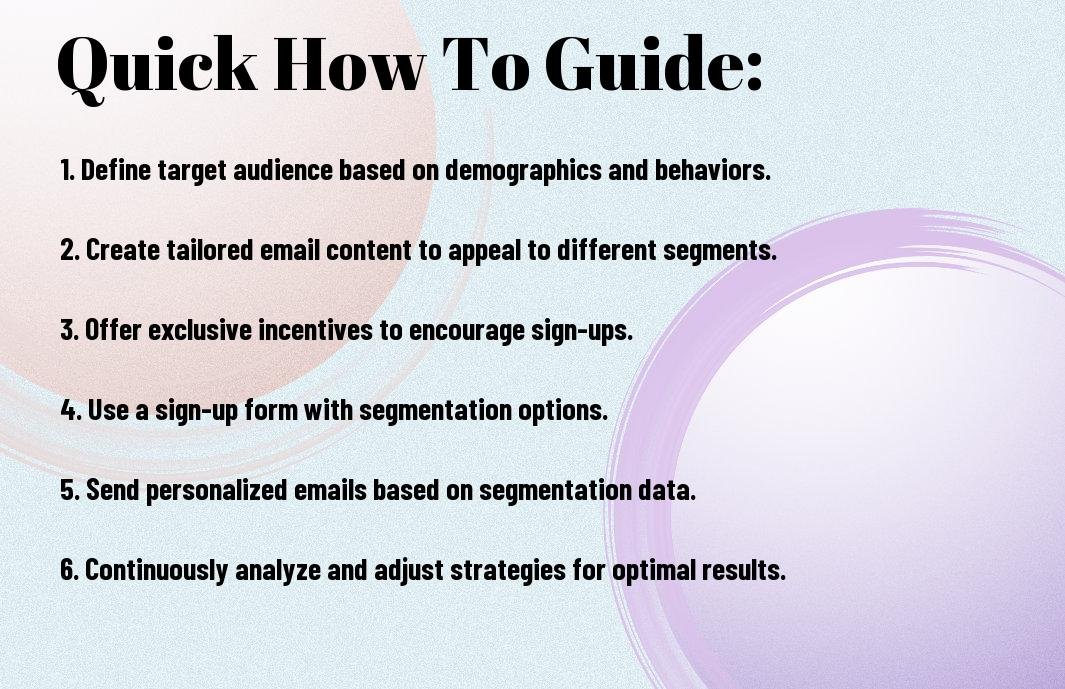Just starting an email list isn’t enough for successful email marketing – you need to segment your list to target the right audience effectively. Segmentation involves dividing your subscribers into specific groups based on their preferences, behaviors, or demographics, allowing you to personalize your emails and send more relevant content. In this guide, we’ll show you how to use segmentation to not only grow your email list but to grow a high-quality one that leads to higher engagement and conversions.

Key Takeaways:
- Segmentation is key: Using segmentation allows you to tailor your email content to specific groups of subscribers based on their preferences, behaviors, or demographics.
- Improve engagement: By sending targeted and relevant content to each segment, you can increase engagement and click-through rates, leading to a higher quality email list.
- Personalization is powerful: Personalizing emails based on segmentation can make subscribers feel valued and understood, resulting in a stronger connection with your brand.
- Regularly analyze and adjust segments: Monitor the performance of your segments and make adjustments as needed to ensure you are effectively reaching and engaging with your subscribers.
- Focus on quality over quantity: Building a high-quality email list through segmentation may take more time and effort, but the results in terms of customer loyalty and conversion rates are worth it in the long run.


Understanding Email List Segmentation
Definition and Benefits of Segmentation
Segmentation is the process of dividing your email list into smaller, targeted segments based on specific criteria such as demographics, interests, or purchase behavior. By segmenting your email list, you can send highly personalized and relevant content to different groups of subscribers, leading to higher open rates, click-through rates, and ultimately, more conversions. This approach helps you tailor your messaging to the unique needs and preferences of each segment, resulting in a more engaged and loyal subscriber base.
Key Factors to Consider for Effective Segmentation
Benefits
- Relevance: By segmenting your email list, you can ensure that each subscriber receives content that is tailored to their interests and needs, increasing the likelihood of engagement.
- Personalization: Segmenting allows you to personalize your messaging, making your emails more compelling and impactful.
- Increased Engagement: Sending targeted content to specific segments can lead to higher open and click-through rates, fostering stronger relationships with your subscribers.
The key to effective segmentation lies in understanding your audience and their preferences. Consider factors such as demographics, past interactions with your brand, and purchase history when creating segments. Tailoring your content to meet the specific needs of each segment is crucial for maximizing engagement and driving conversions.
How to Segment Your Email List
Tips for Collecting Subscriber Data
Now, when it comes to building a high-quality email list, collecting relevant subscriber data is key. One effective way to do this is by offering valuable content in exchange for email sign-ups. Make sure to create engaging opt-in forms on your website and social media platforms to capture important information about your subscribers.
- Use online quizzes and surveys to learn more about your subscribers’ preferences.
- Offer exclusive content or discounts to incentivize subscribers to share more information.
- Segment subscribers based on their past interactions with your emails to personalize future campaigns.
After implementing these strategies, you will have a better understanding of your subscribers’ interests and preferences, allowing you to create targeted email campaigns that resonate with them.
Techniques to Segment Your Subscribers
Now, when it comes to segmenting your email list, there are several techniques you can use to ensure your campaigns are tailored to the specific needs and interests of your subscribers. A great way to start is by segmenting based on demographics such as age, location, or gender. This can help you create more personalized and relevant content for different groups of subscribers, increasing engagement and conversion rates.
Implementing Segmentation Strategies
How to Personalize Content for Each Segment
Your email list is full of diverse subscribers with unique preferences and interests. To engage them effectively, personalize your content for each segment. Tailor your messages based on demographics, behavior, or purchase history. By delivering relevant content, you can increase open rates, click-through rates, and ultimately, conversions.
Automation and Workflow Tips for Segmented Lists
An efficient way to manage segmented lists is through automation and workflow strategies. Use email marketing tools to set up automated campaigns that trigger based on specific actions or time intervals. Create workflows that streamline the process of sending targeted messages to different segments. This approach can save you time and ensure consistency in your email marketing efforts.
- Utilize automation tools to streamline processes.
- Create workflows based on subscriber behavior.
- Segment your lists based on demographics or interests.
- Personalize content for each segment.
With automation and workflow tips, you can effectively manage and engage with your segmented email lists. By leveraging the power of automation tools, you can save time and resources while delivering targeted messages to the right audience. This can lead to higher engagement rates and better overall performance of your email marketing campaigns.
Measuring Success and Adjusting Strategies
Identifying Metrics to Track
Unlike other marketing strategies, email segmentation allows you to measure success with a higher level of precision. Assuming you have set clear goals at the beginning of your segmentation campaign, it is crucial to identify the key metrics to track. These may include open rates, click-through rates, conversion rates, unsubscribe rates, and overall engagement metrics. By monitoring these metrics regularly, you can gain valuable insights into the effectiveness of your segmentation efforts.
How to Analyze Data and Refine Segments
Measuring the success of your segmentation strategy goes beyond just tracking basic metrics. It involves analyzing the data collected from your campaigns to refine your segments continuously. By identifying patterns in subscriber behavior, preferences, and interactions with your emails, you can tailor your segments even further for increased effectiveness. Measuring these metrics allows you to make data-driven decisions when refining your segments to ensure they are targeted and relevant to your audience.
Metrics play a critical role in the success of your email segmentation strategy. By analyzing key metrics such as open rates, click-through rates, and conversion rates, you can determine which segments are performing well and which need refinement. It is vital to pay close attention to unsubscribe rates as they can indicate when a segment is not resonating with your audience. Additionally, focusing on engagement metrics can help you understand how well your segments are connecting with subscribers and guide you in making necessary adjustments to improve overall performance.

Advanced Segmentation Tactics
- Predictive Segmentation Using AI
Predictive Segmentation Using AI
Advanced segmentation tactics involve leveraging artificial intelligence to predict customer behaviors and preferences. By analyzing large datasets, AI can help identify patterns that humans might miss, allowing for more accurate segmentation. This enables you to send targeted emails to specific segments based on predicted actions, increasing engagement and conversions.
- Lifecycle Email Marketing and Behavioral Triggers
Lifecycle Email Marketing and Behavioral Triggers
One of the most powerful segmentation tactics is using lifecycle email marketing and behavioral triggers to send the right message to the right person at the right time. By tracking how subscribers interact with your emails and website, you can create personalized campaigns that nurture leads and drive conversions. This approach focuses on delivering relevant content based on the subscriber’s stage in the customer journey, increasing the chances of success.
Email segmentation tactics like predictive segmentation using AI and lifecycle email marketing with behavioral triggers can significantly improve the effectiveness of your email marketing campaigns. By using advanced technology and data-driven insights, you can deliver highly targeted and personalized messages that resonate with your audience, ultimately leading to higher engagement rates and greater ROI.
Conclusion
Drawing together all the insights from this guide on how to use segmentation to grow a high-quality email list, it is evident that tailoring content based on subscribers’ interests and behaviors is key for success. By dividing your audience into segments and sending targeted, relevant messages, you can increase engagement, build stronger relationships, and ultimately drive conversions. Implementing segmentation strategies will not only help you grow your email list but also ensure that you are delivering value to your subscribers, fostering long-term loyalty and brand advocacy.
FAQ
Q: What is Segmentation in Email Marketing?
A: Segmentation in email marketing is the practice of dividing your email list into smaller, targeted segments based on specific criteria such as demographics, behavior, or preferences. This allows you to send more personalized and relevant content to your subscribers.
Q: Why is Segmentation Important for Growing a High-Quality Email List?
A: Segmentation is important for growing a high-quality email list because it helps you deliver more targeted and relevant content to your subscribers. By sending personalized emails based on their interests and behavior, you can increase engagement, click-through rates, and ultimately, conversions.
Q: What are the Different Types of Segmentation Strategies?
A: The different types of segmentation strategies include demographic segmentation (based on age, gender, location, etc.), behavioral segmentation (based on past interactions with your emails or website), psychographic segmentation (based on interests, values, lifestyle), and firmographic segmentation (based on company size, industry, revenue).
Q: How Can I Implement Segmentation in My Email Marketing Strategy?
A: To implement segmentation in your email marketing strategy, start by collecting data from your subscribers such as their preferences, behavior, or purchase history. Use an email marketing platform that allows you to create segments based on this data. Then, create targeted email campaigns for each segment to deliver personalized content.
Q: What are the Benefits of Using Segmentation to Grow a High-Quality Email List?
A: The benefits of using segmentation to grow a high-quality email list include increased engagement, higher open and click-through rates, reduced unsubscribe rates, improved deliverability, better ROI on email marketing campaigns, and ultimately, more satisfied and loyal subscribers.

